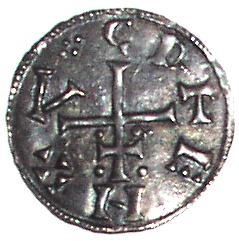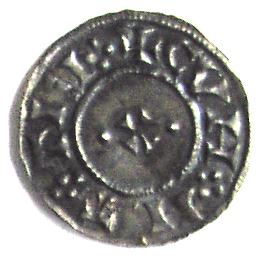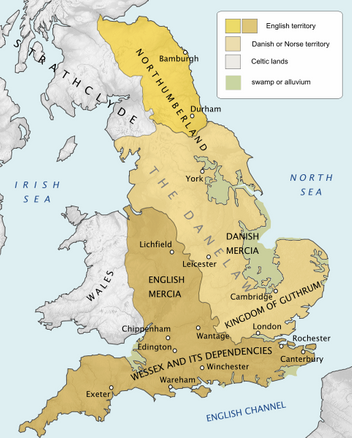Viking Kingdom of York, "Hunedeus and Cnut", 'Cunetti' Group (c.895-902), Penny, 1.42g., York mint, small cross with pellet in 1st and 4th angle, +CVNNETTI around, rev., CR T EN (Cnut Rex) around patriarchal cross, with a pellet in angle of the smaller cross.
The inscription
The king's name, CNVT - Cnut, is written in such a form that you make the sign of the cross when you read it, as in a blessing - up, down, left, right - and between these letters is the word REX ('king').
In the centre is a large and elaborate 'patriarchal' cross that had special meaning for the Church. On the other side, the inscription reads MIRABIL[I]A FECIT, which is Latin for 'He has done wonderful things' - a quotation from Psalm 98, v.1.
The Viking kingdom of York
The Scandinavian micel here ('great army') arrived in England in 865 and for years it moved from one region to another attacking, stealing and even conquering. The Viking kingdom of York was established in 876 by Halfdan, one of the leaders of the army.
The coinage is one of the few sources of evidence which have survived about the kingdom. It is surprising to find that some of Halfdan's successors in the late 890s and early 900s were producing a large coinage that was more overtly Christian than any other in Europe at that time.
The Christian and Viking imagery on the coinage
The Christian symbolism on this and other York issues of the period shows that the new Scandinavian kingdom not only adopted Christianity towards the end of the 9th century, but saw it as politically correct to publicise it.
They wanted to demonstrate to their Anglo-Saxon, Carolingian and Celtic neighbours that they possessed qualities which would link them to the block of civilised Western states.
In the 920s, faced with the threat of reconquest by the Anglo-Saxons, the Viking kings of York saw a resurgence of Norse nationalism when symbols such as Thor's hammer and ravens with spread wings appeared on the coins.
A dual bullion economy
A dual economy existed in Danelaw which typified the blending of Anglo-Saxon and Scandinavian cultures characteristic of the region.
Despite the sophistication of the York coinages, the traditional 'bullion' economy survived in the Scandinavian community. For some purposes transactions were conducted with silver weighed out, rather than using coins at their face value.
So we find hoards containing a mixture of Viking coins, foreign coins such as Islamic dirhems brought across Russia and Scandinavia, and 'hack-silver' - cut pieces of silver plate and ornaments.
Also see link to info on the Danelaw area
A lot of these type of coins where found in the so called Cuerdale hoard, see link
Well. I could have been with these stones until after dark, but as my wife wanted to travel on.. well.. I see you again, some day, hogback stones from Gosforth. And if you happen to be there one day, do not forget that monument on the outside...
Further on with the Cumbrian hogbacktour !
In - yes, luckily again in - St. Peter's church in Heysham, there is a truly beautiful hogback stone. The guide told us, it had been studyied by Thor Ewing, a writer, in 2000. in 'Understanding the Heysham hogback' A tenth century sculpted stone monument and its context (link), Thor Ewing tells in detail what he dicovered on the both sides of this hogback stone.
Just being brought in the church as late as the 1970's accompanied with some protest here and there among the church visitors, considered as being a token of old paganism, it had been remarkably nice preserved, and a lot of detail can be seen, still. Truly worthwile a visit.
I had a small debate with the guide in the church if the - zoomorphic, in my opinion - faces on the sides were lions (or hippo's). The guide doubted if the vikings could have known about lions. Well I guess so, concerning the runes on the Ancient Greek lion statue at the Arsenal, Venice. For example. Vikings did travel south..
But when he told me he was doubting the vikings 'discovered' (as the native inhabitants were of course, in the first place) America before Columbus, I decided to rest my case..
One has to know when to start and to end a conversation ..
Just discovered the book in a bookstore written by Geoff Holder - The guide to the mysterious Lake District, I knew there had to be another hogback stone in Lowther, St. Micheal's Church. With a promising image described in the text of 'a naval and a land-based force of shield-bearing vikings above a fish and what might be a coiled sea serpent. On the reverse is a row of female figures with snakes, possibly a representation of the hideous hag Hel'. Wow. If that did not sound as a true pagan promised land ..
Not complaing too much after all we have seen, this visit was the dissapointing one of them all. But if you wife states 'I am happy to have seen them' and I am answering 'Measuring is knowing' and the even more obligate verb 'handling 'if we did not see it at all, we wouldn't have known anything at all of how they were looking' the glass was again half full, at the last day of our journey..
The hogback stone appeared to be just being tolerated within the entrance segment part of the church. As something you never use anymore but you do not throw away - entirely. That sort of feeling emerged when seeing this hogback asylum seekers.. Bed, bath and bread, ás we say in Dutch, but no luxury at all and standing on some outcuts of wood, you would balance the table with at home..
Come on, St. Micheal's Church.. care a bit more of your 'children' !
This hogback stone was moved in the church in 1907. Hogback stones layed partially buried in the churchyard before it was dug up and moved into the church.
The promising depiction of a longship - as certainly can be seen after some studying - see http://vikingminds.co.uk/pages/longship
we have missed !
The stone itself is (157 x 50 x 30 cm) and very worn.
The hogback stones in Cumbria - very diverse in quality, but everyone worth a visit ! Especially on a gloomy day in late October ...
The churches to visit - see photos of resp. St. Andrew's church in Penrith, St. Mary's church in Gosforth, St. Peter's church in Heysham and St. Micheal's church in Lowther.
Did I miss out on another one in Cumbria ? Let me know !
In a next blog I will take you to four - still remaining utterly mysterious- statues 'guarding' the graveyard of St. Andrew's church in Dacre..
For the last blog of October 9th see this link.
References: (as always, links to where the books can be ordered are attached).
Edwards, B.J.N. Vikings in North West England - The artifacts (1998);
Emery, Gordon, CURIOUS CUMBRIA, The Lake District & Beyond: A celebration of Cumbria (2023)
Ewing, T. 'Understanding the Heysham hogback' A tenth century sculpted stone monument and its context ;
Hall, R. Viking Age archaeology in Britain and Ireland (first printed 1990, reprinted with amendments in 1995);
Holder, G. The guide to the mysterious Lake District (2009)
possibly also (as there within the part of Cumbria dealing with Carlisle, the Eden Valley, Barrow-in-Furness, Whitehaven and the west coast is being dealed with)
Holder, G. Paranormal Cumbria (2010)
http://vikingminds.co.uk/pages/longship


